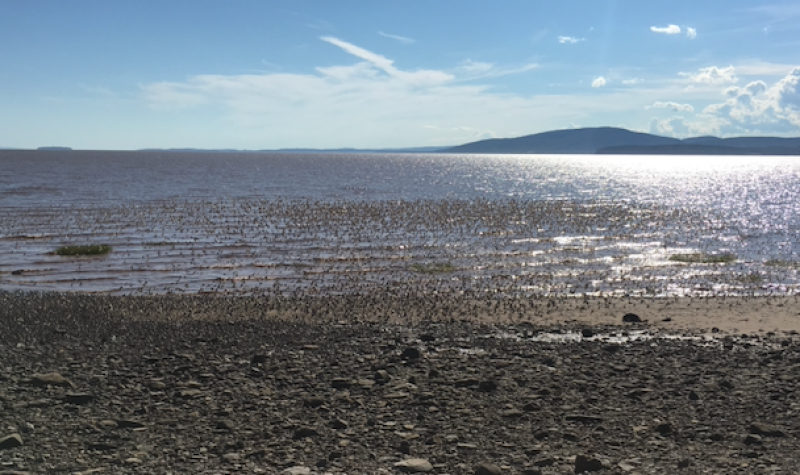It’s that time of year again. Tens of thousands of semipalmated sandpipers and other shorebirds are gathering at the mudflats near Johnson’s Mills on Dorchester Cape, in a weeks-long feeding frenzy that will help them make their annual migration from breeding grounds in the Arctic all the way to South America. More than a quarter million shorebirds–about 30% of the world’s population–return to the Bay of Fundy’s tidal mudflats each year, according to the Nature Conservancy of Canada.
The Nature Conservancy’s observation deck and shorebird information centre at Johnson’s Mills is a popular spot to view the massive flocks of birds. CHMA stopped by on Monday to see and hear the goings on:
“I get down here several times per season,” said Sackville resident Paul Cant on Monday. “They put on a great show today, about 30,000 of them performing for us. It’s always spectacular to watch, and even to just see them on the beach walking around.”
Suzanne Smith from Campbellton was delighted with the display on Monday. “This is what I’ve been wanting to see for years,” said Smith. “They’re just amazing how they’re so close, and they they’re so camouflaged. And then when they all go up and just start swirling around, it’s just amazing.”
Zoe Estabrooks is manager of the interpretive centre at Johnson’s Mills, which is just off Route 935, about 10 minutes south of Dorchester. Estabrooks says the best time to see the birds is in the four-hour stretch surrounding high tide, when they are closer to shore. Estabrooks recommends using observation points off the beach—such as the deck at the centre—so as not to disturb the birds as they rest between feeding times.

The mudflats at Johnson’s Mills stretch out about two kilometres at low tide, which means the birds have a large area in which to feed on the mud shrimp that draws them to the Bay of Fundy. The birds will double their weight in the few weeks they spend on the mudflats, eating up to 30,000 to 40,000 mud shrimp a day. “That would be like an adult [human] eating 150 Cheeseburgers a day,” says Estabrooks.
The migratory feat of the shorebirds is notable: they double their weight in order to survive a 5000 kilometre non-stop journey southward. But what really draws oohs and ahhs from spectators is the incredible movement of the birds.
“They fly as a school of fish swim,” says Estabrooks, “so just as one turns, they all turn.” And with flocks reaching a large as 100,000 in number, it’s an impressive sight. “No one knows exactly how they do it to this scale,” says Estabrooks. “We’d love to ask them but unfortunately they they won’t tell us.”
The Nature Conservancy of Canada posts high tide and ideal viewing times on their website. Here are the times for rest of this week:
- August 17: 2:55 p.m.-6:55 p.m. (High tide at 4:55 p.m.)
- August 18: 3:44 p.m.-7:44 p.m. (High tide at 5:44 p.m.)
- August 19: 4:37 p.m.-8:37 p.m. (Hight tide at 6:37 p.m.)
- August 20: 5:09 a.m.-9:09 a.m./ 5:34 p.m.-9:34 p.m. (High tide at 7:09 a.m./7:45 p.m.)
- August 21: 6:09 a.m.-10:09 a.m./6:25 p.m.-10:25 p.m. (High tide at 8:09 a.m./8:25 p.m.)


